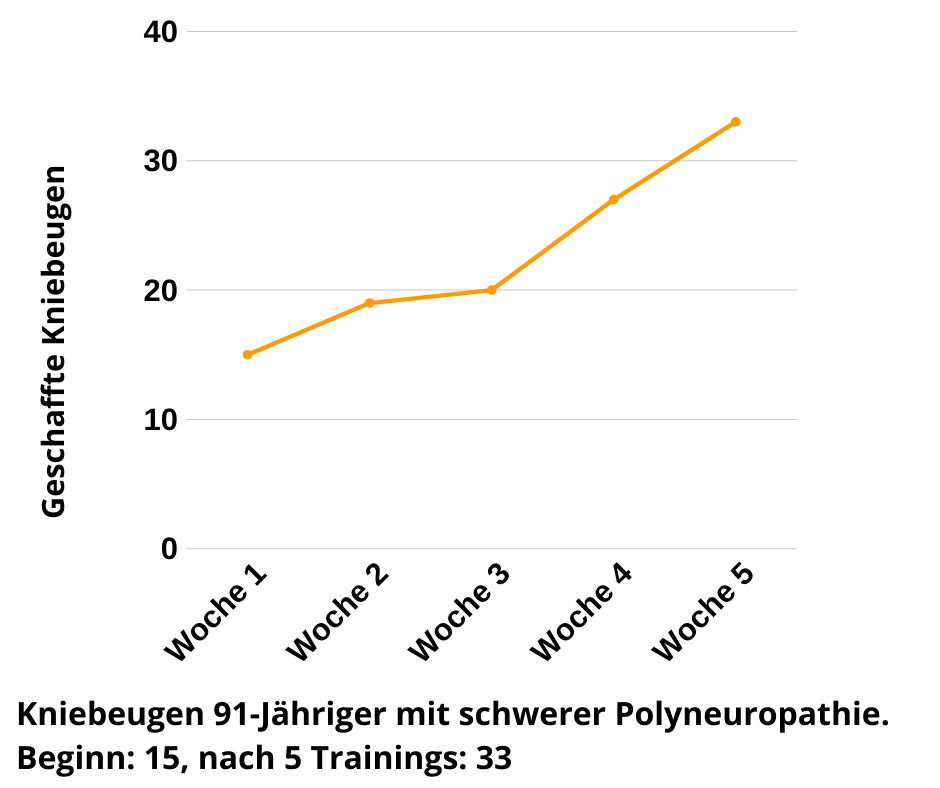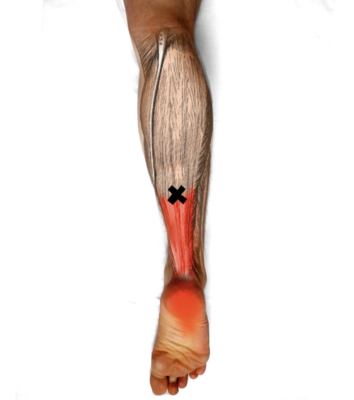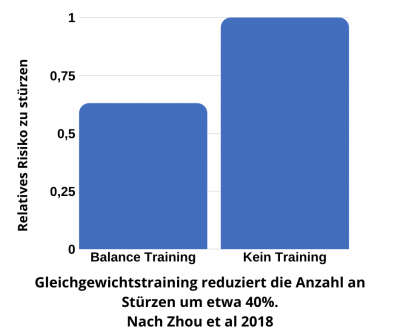Does sport help with polyneuropathy?
Sport helps with a variety of illnesses.
It has some form of benefit for almost every chronic illness.
But does this also apply to sport for polyneuropathy?
Can nerve damage be improved with sport?
What kind of sport works in what way and what kind of exercise is particularly important for polyneuropathy?
I would like to answer these questions in this article.
Recommended sport for polyneuropathy
In brief, the following components can be recommended for sport with polyneuropathy:
- Balance and coordination training
This will improve your body awareness and reduce the risk of falling and injury. - Endurance training such as walking, cycling or swimming.
This improves blood circulation and metabolism and can therefore have a positive effect on the course of polyneuropathy. - Strength training specifically for the affected lower legs or hands
This will help you maintain your muscle strength so that you remain mobile.
Strength training also strengthens the bones and makes them more resistant to fractures, making falls less dangerous. - Stretching exercises and massages for the affected body parts.
Because polyneuropathy very often causes muscle stiffness and pain, the muscles should be loosened by stretching and massage.
There are no sports that are fundamentally harmful for polyneuropathy.
Which sport is good for the individual depends on their own abilities and the severity of the polyneuropathy.
In principle, all sports can be practiced, especially if the polyneuropathy is not yet very pronounced and the level of difficulty is adapted.
People who have a lot of experience in a sport can often still do it even with advanced polyneuropathy.
Learning a new sport may be more difficult, but it is not impossible.
During all sporting activities, you should be aware that polyneuropathy increases the risk of falls and injuries and take appropriate precautions.
Can I still do sport at all?
Many people with polyneuropathy wonder whether their body is still capable of doing sport at all if they suffer from polyneuropathy.
The answer is yes, the more you exercise, the better!
Some people who exercise despite polyneuropathy achieve impressive fitness despite the condition.
If you do a lot for yourself, you will also benefit a lot.
From my own experience, I know patients who can still ski or windsurf despite severe polyneuropathy and although they have virtually no perception of their feet.
Because everything that you continue to practise, you can continue to do better.
Of course, you can't just carry on as before with polyneuropathy.
There are a few things to bear in mind.
In particular, the increased risk of falling plays a major role.
For this reason, you should incorporate special exercises into your training and everyday life to reduce the risk of falling.
You can find out how to do this and what else you need to know about sport and polyneuropathy in this article.
Endurance sports and polyneuropathy
Endurance training is associated with an incredible number of positive effects on health.
The blood vessels, sugar and fat metabolism, even the immune system and the psyche benefit from endurance sport.
This is why people with polyneuropathy should not do without it.
Those who take it easy due to polyneuropathy instead of staying active will soon have to struggle with the negative consequences of a lack of exercise.
Nevertheless, you can't just go about your sport as if nothing were wrong.
Which sport is recommended for you personally depends primarily on how severe the polyneuropathy is and how much experience you have with a sport.
Avoid falls due to polyneuropathy
The most important restriction in sport is the impaired movement control caused by polyneuropathy.
People with poorly functioning nerves are also less able to perceive and control their muscles and joints.
As a result, it takes a little longer to react to disturbances such as tripping.
As a result, there is a higher risk of falling and injuring yourself.
This is not only important if you want to take part in (fall) risk sports such as ball sports, skiing or inline skating, for example.
As a polyneuropathy patient, you are also at greater risk of falling when jogging and walking.
The best protection against falls and injuries with polyneuropathy is good balance
To protect yourself from injuries and falls, it is of course important to exercise a little more caution when playing sports with polyneuropathy.
This means it makes sense to wear shoes that are as good as possible and only choose routes that are not too demanding.
If you are just starting a new training program, you should not necessarily train alone, but take training partners with you who can help you in an emergency.
However, it is also crucial not to give yourself too little credit.
If you only take it easy and no longer face any challenges, you will soon be capable of less and less.
The best protection against injuries and falls is your own skills.
And they get better the more you practise and the better trained you are.
Balance training is particularly important in polyneuropathy to prevent injuries
Good coordination and balance are crucial for this.
If you can keep your balance well, you are less likely to fall.
For example, if you can stand on one leg with your eyes closed, the risk of falling is much lower than if you are already swaying when standing normally.
People with good balance are less likely to fall, twist their joints or suffer broken bones.
The good news is that balance is easy to train, especially for people with polyneuropathy.
This means that if your balance is poor now, it can certainly be improved again.
If you currently have poor balance due to polyneuropathy, you will particularly benefit from training.
Especially if you are very weak at the moment, you can achieve a lot through training.
Good training can make the difference between walking normally and using a rollator!
Train the nervous system instead of the muscles
Because when you train your balance, you have to constantly react appropriately to small fluctuations in your body.
This means that the body must be constantly and very precisely perceived and responded to.
When you train in this way, you improve the function of the nervous system.
In other words, you are training exactly what polyneuropathy makes worse: To perceive the body accurately and control movements precisely.
This means that the better your balance, the less the polyneuropathy will affect you.
Balance training also helps to alleviate some of the pain and discomfort caused by polyneuropathy.
Through training, the nervous system learns to compensate for the nerve damage to a certain extent.
And this improves the symptoms of polyneuropathy.
A detailed explanation of balance exercises specifically for polyneuropathy can be found here:
Does endurance sport help with polyneuropathy?
This means that balance training helps to counteract the limitations caused by polyneuropathy.
But does pure endurance training also help the nerves directly, i.e. against polyneuropathy?
Of course, it has already been tested and examined whether the nerves benefit from endurance sports.
It has been shown that endurance training does indeed have an effect on the nerves.
People who do endurance training slow down the progression of polyneuropathy a little.
However, this effect is quite small and hardly noticeable in everyday life.
However, if endurance training is carried out at the same time as balance training, the two forms of training complement each other, resulting in significantly better effects on polyneuropathy.
The training then has a double benefit: the polyneuropathy improves or worsens more slowly and general fitness improves at the same time.

Better fitness = better health
The fact that endurance training improves your fitness sounds like a nice side effect at first.
However, good fitness is a prerequisite for good health, even apart from the state of your nerves.
In order to be able to do endurance sports, the body has to absorb a lot of oxygen and transport it to the right places.
This is why all organs that transport oxygen benefit from endurance training.
In other words, if you have endurance, your lungs, heart and blood vessels function better.
This effect is so strong that people who suffer from chronic diseases have the same life expectancy as healthy people despite their illnesses - if they are physically fit.
There is a similar correlation for the speed at which you can walk.
Numerous studies have investigated the mortality rates of people who can walk at different speeds.
Maintaining performance is therefore also crucial for the health of people with polyneuropathy.


Which endurance sports are particularly recommended?
There is no such thing as "the" endurance sport for polyneuropathy patients.
It all depends on your personal preferences and your state of health.
If you are severely restricted by polyneuropathy, swimming or aqua aerobics are highly recommended.
When swimming or aqua jogging, you will notice the restrictions caused by the nerve damage much less than on land.
Rowing, for example on rowing machines, is highly recommended because you can work in a seated position and have no problems keeping your balance.
You should only do other endurance sports if you have experience with them and your movement control is not yet very poor.
When walking, you should be aware that there is a relatively high risk of falling.
Although walking is very useful for staying fit for everyday life, you should be a little more careful and only choose routes where there is no great risk of tripping.
You can also use poles to help you walk more stably.
If this is also too unsteady, it makes sense to walk quickly with a rollator.
Cycling is generally possible despite polyneuropathy.
Even if you are severely restricted due to polyneuropathy, you can still ride an exercise bike.
If you want to go jogging despite polyneuropathy, you should be aware that there is an increased risk of falling or twisting your ankle.
You should therefore choose routes where the risk of tripping is low.
In addition, overloading can occur quite quickly if you no longer perceive your feet properly and therefore do not recognize the body's warning signals.
Experienced athletes usually have these problems under control despite the polyneuropathy.
For beginners, however, jogging with polyneuropathy is relatively risky.
If you are very fit, you can also carefully try cross-country skiing, preferably in classic style.
This is especially true if you already have experience.
This not only trains your endurance, but also your coordination and balance.
However, choose easy routes.
If you are going downhill, you can leave the cross-country ski trail and ski next to it on unprepared snow.
This will not make you as fast.
The snow is also softer there, so you won't injure yourself as easily in the event of a fall.
The right intensity for endurance training
Patients with polyneuropathy can usually exercise at the same intensity as healthy people.
Only if your heart is affected by polyneuropathy should you first speak to your doctor to clarify how much you can exert yourself.
As a rule of thumb, you should push yourself so hard that you can barely speak.
At this intensity, the risk of overloading yourself is very low and you are still training your heart and lungs very intensively.
Incidentally, this rule of thumb is more suitable for training control than heart rate limits.
This is because the heart rate is very individual.
Some people have a high heart rate even at low exertion, others always have a very low one.
In practice, it is therefore better to control the training intensity via breathing.
As I said, the effort at which you can still just talk is almost always a very good target value.
It can also be useful to do intervals.
This means, for example, that you train very slowly for 4 minutes and then quickly for 1 minute.
This form of training is particularly useful if you only have a limited amount of time available.
Strength training and polyneuropathy
It is obvious to everyone that it is an advantage to have strong muscles.
Muscle building and strength training is even more important for polyneuropathy than for healthy people for a variety of reasons:
- Strong muscles partially compensate for problems caused by polyneuropathy
- Strong muscles protect against falls and broken bones
- Strength training causes more nerve endings to grow in the muscles
- Strength training has a positive effect on the course of polyneuropathy
Strength training makes bones stronger - even with polyneuropathy
Strong muscles also make strong bones.
When the muscles work, they pull on the bones.
This causes slight stress.
The bone reacts to this by incorporating more calcium.
This makes the bone stronger - and in the right places.
The structure of the bone, the bone beams, thus becomes more stable and fracture-resistant.
This means that people with strong muscles are more likely to survive falls and accidents unscathed than those with weak muscles.
And this is particularly important if you suffer from polyneuropathy, as you are unfortunately more likely to trip and have a higher risk of falling.
Incidentally, this effect on the bones only occurs through mechanical stress.
It is not enough to have a diet high in calcium.
This is because the stimulus that causes the bones to incorporate calcium is mechanical stress, i.e. the tension and pressure exerted by the muscles.
This means: without exertion, no strong bones!
The load must be heavy enough!
Incidentally, the force applied must be high enough.
To increase bone strength, at least 70% of the maximum force must be applied.
This means, for example, lifting a weight that you can lift a maximum of 10-12 times.
If you do strength exercises with light weights, your bones will unfortunately hardly benefit.
There is another effect that is interesting for polyneuropathy: when you lift heavy loads, more nerve endings grow in the muscle.
In no human being are all the fibers of a muscle activated at the same time.
However, when you train with heavy loads, the body learns to reach more fibers by allowing more nerve endings to grow into the muscle.
Here too, however, the load must be relatively high.
These effects cannot be achieved with light exercises.
Damaged nerves reach fewer muscle fibers
A common problem with polyneuropathy is that the nerves no longer reach all the muscle fibers.
This is because each muscle fiber has its own nerve ending.
This activates the muscle fiber and thus triggers movement.
Without nerves, there is no muscle work!
In many polyneuropathy patients, however, the nerves can no longer reach all the muscle fibers.
Of course, this also limits strength, because a muscle in which only a few muscle fibers are working is naturally weaker.
However, this can also be trained.
When a muscle is trained, this not only causes the muscle fibers themselves to adapt, but also the nerves that control this muscle.
Interestingly, even in healthy people, not all muscle fibers work at once; only around 60% can be activated at the same time.
This percentage increases when you do strength training.
Strength training therefore increases the number of muscle fibers that work simultaneously.
(This is the famous intramuscular coordination).
This increases the strength of the muscles without making them bigger.
This is also the reason why some petite-looking people can muster great strength: They are simply better at targeting their muscle fibers in a coordinated way.
In competitive sports, this would be ski jumpers or climbers, for example.
They need to be as light as possible for their sports, so they shouldn't be carrying around mountains of muscle, but they still need a lot of strength.
These athletes use special training for this, which you can also take advantage of.
Activate more muscle fibers through strength training
Despite polyneuropathy, it is still possible to "learn" to activate more muscle fibers through strength training.
This increases muscle strength despite the polyneuropathy.
It is also important here to provide sufficient resistance.
This is because the nervous system only adapts if you apply a force that is at the limit of your personal capacity.
If your state of health allows, you should therefore perform exercises that offer as much resistance as possible.
For example, things that you can do just once or twice.
This so-called maximum strength training has the greatest effect on the nervous system.
In addition, the effort only lasts a few seconds, which suits many people.
But even with gentle strength training, a significant increase in muscle strength is possible despite polyneuropathy.
It is usually possible to increase strength by 30-50%.
There are also people who double their strength through regular training.
Being so much stronger naturally makes everyday life much easier.
The diagram on the right shows the squat performance of one of my patients with severe polyneuropathy at the age of 91.
He managed to increase the number of squats he did in one go from 15 to 33 in 5 weeks.
That's more than double.
All he needed was a little practice and: The knowledge that it was even possible.
Because many people think they are too ill or too old to increase their strength.
As you can see, the training still works even in old age and despite the polyneuropathy.
Strength training also works in old age

Strength can still be increased even with polyneuropathy
By the way, I didn't choose this patient as an example because he is exceptionally good, but because this improvement is normal if you practise regularly.
Of course, there are natural limits to this training effect, which also depend on the severity of the polyneuropathy.
If the nerve that supplies a muscle fiber no longer functions at all, it can of course no longer perform any muscle work or produce any training effect.
In this case, however, it is possible to train the remaining nerves and muscle fibers and still at least maintain strength.
Strength exercises for the legs
To train the strength of your legs, it is best to do three different exercises: One for the thighs, one for the calves and one for the foot lifts.
I will show you exercises of varying degrees of difficulty for all these games.
The first exercise is always the easiest.
Choose an exercise that you can do 8-15 times.
If you manage many more repetitions, the exercise is too easy and you can progress to the next more difficult variant.
Strength exercises for the thighs
- Standing up and sitting down
Sit down on a chair.
Stand up and sit down again.
And then sit down again.
If possible, do the movement freehand.
Stand up and sit down again until you feel a clear sense of exertion. - Squats
Stand with your legs shoulder-width apart and bend your knees.
Lean forward in your upper body, which will allow you to reach further down without putting strain on your knees.
Try to bend your knees to 90 degrees.
If you have problems keeping your balance, stand across a doorway and hold on to the door frame. - Single-leg squats
Do the same movement as normal squats, but on one leg to train the leg in question more intensively.
Hold on to a stable object (a door frame is ideal).
Try to bend your knee to 90 degrees.
Make sure you do not push your knee further forward than the tip of your foot.
Strength exercises for the calves
Training the calves is particularly important with polyneuropathy, as they are especially affected by the loss of strength.
Well-trained calves allow you to walk elegantly and easily.
The following exercises will help you maintain and increase the strength of these important muscles:
- Stretching your feet with the elastic band
Sit on a chair and place an elastic band over the ball of your foot.
Hold the ends of the band in one hand, so that the middle of the band is on the ball of your foot.
Now stretch your leg out horizontally in front of you.
Pull on the band with your arms.
Now bend and stretch the ankle joint with the strength of your calves. - "Calf raises to tiptoe
Stand up straight and hold on to the back of a chair.
Raise your body with the strength of your calves until you are standing on your toes.
Now lower your body again until your heels touch the floor again.
Repeat this movement until you feel a strong sense of exertion in your calves.
Be careful not to sway back and forth with your whole body.
The movement should mainly come from the ankle joints - "One-legged calf raise
Stand behind a chair and hold on to the backrest.
Now lift one leg off the floor.
Now lift your body with the force of the calf of your supporting leg until you are standing on your toes.
Now lower your body again until your heel touches the floor again.
Repeat this movement until the calf muscles are very tight.
Again, make sure that you mainly use the strength of your calves to move the ankle joint and do not use your whole body to gain momentum.
Training the foot lifts for polyneuropathy
Many people with polyneuropathy develop weak foot dorsiflexion over time.
This means that they are no longer able to lift the top of their foot.
This can result in frequent stumbling and falls.
The better trained your muscles are, the more likely you are to avoid these problems in the long term.
The following exercises will increase and maintain the strength of your foot lifts:
- Lifting the tip of the foot while sitting
Sit on a chair.
Now raise the tip of your foot and put it down again.
The further the leg is extended in the knee joint, the easier the exercise will be. - Toe lift with resistance
To make this exercise more challenging, take a stick (a broomstick or ruler will also work) in your hand.
Place one end of the stick on the tip of your foot.
Now press the tip of your foot against the stick and pull it upwards.
The harder you hold against it with your hands, the more intense the exercise will be for your foot lifts.
You should feel the exertion on the front of your shin during this exercise.
This is where the muscles that lift the foot are located.
Strong muscles compensate for weaknesses elsewhere in polyneuropathy
New solutions can be found for many everyday problems when the old ones no longer work
For example, if you are no longer able to apply much force with your calves, your thighs can do more work instead.
Of course, the thighs have to be strong enough for this.
So you need strong muscles in many places to manage well despite polyneuropathy.
It is therefore important to train the whole body and not just individual parts.
You should also start in good time, because if you wait until you can only manage with help before you start training, it will of course be more difficult.
So invest in your fitness in good time!
Does strength training help against polyneuropathy?
Whether there is a direct effect on the symptoms of polyneuropathy or even on nerve damage is of course a crucial question.
So: does strength training for polyneuropathy also benefit the nerves, not just the muscles?
Of course, studies were carried out on this, i.e. strength training was tested with polyneuropathy patients and the severity of the polyneuropathy was examined.
The results showed that strength training alone has a small positive effect on nerve damage.
In other words, those who do strength training show slightly fewer symptoms of polyneuropathy such as pain, numbness and paresthesia.
However, the effect is quite small.
However, if you combine strength training with balance exercises, the effects complement each other. This means that if you do balance exercises like those in my exercise guide "Exercise for polyneuropathy" at the same time as strength training, you will benefit considerably more.
Playing sports and polyneuropathy
In principle, it makes a lot of sense to continue doing sports that you are already good at and that you enjoy.
Even if you suffer from polyneuropathy.
For example, if you enjoy playing soccer, you should continue to do so - within your own capabilities.
Because everything you stop practising gets worse.
And this also includes things that you train in game sports: Reactivity, speed, endurance and coordination.
As soon as you stop playing your sport, these things will deteriorate.
You should therefore continue as long as your diseased nervous system allows.
However, you should adjust the level and cut back a little depending on your state of health.
It often makes sense to do slightly modified forms of sport.
Variants that do not involve competition are best.
For example, if a basketball player is no longer fit enough for a competitive game, he can still simply shoot baskets.
A footballer can kick the ball around with a friend, a tennis player can do technical exercises.
The risk of injury is then low, but you still have fun and physical benefits!

Balance training reduces the injury rate in ball sports
Incidentally, the following applies to all ball sports, whether with or without polyneuropathy: good balance protects against injuries.
Especially in the ankle and knee.
The most common sports injury of all, twisting of the ankle (medically known as supination trauma) can be reduced by more than half with a little balance training!
You can find an excellent study on this here.
If you want to read more about injury prevention, I recommend the following article: Never twist your ankle again
Sport despite polyneuropathy
As you can see, sport and polyneuropathy are not mutually exclusive.
If you know how, you can actually do yourself a lot of good through sport and training with polyneuropathy.
It is important to train your balance in particular, as this stimulates the nervous system and improves its function.
It also helps to prevent falls and injuries.
My most important piece of advice is: stay active, despite polyneuropathy!
Stretching exercises for polyneuropathy
Stretching exercises can also be beneficial for polyneuropathy, but in a different way than you might initially think.
The first question to clarify is whether stretching can directly help the nerves.
The concept of nerve stretching, i.e. special exercises that stretch the nerves rather than the muscles, has been around for a long time.
This usually involves performing a classic stretching exercise and moving the head at the same time.
As all nerves ultimately lead to the brain and therefore to the head, they can be stretched in this way.
It is therefore perfectly possible to stretch the nerves in a targeted manner.
However, it is not clear whether this triggers positive effects.
After all, stretching something, i.e. basically pulling on it, does not automatically trigger a healing process.
Stretching exercises are helpful in animal studies
So far, there have only been animal experiments in which the poor test animals were administered toxins that triggered polyneuropathy and nerve stretching was performed at the same time (Zhu et al. 2018).
The nerves that were stretched actually developed less severe polyneuropathy.
However, whether this effect can be transferred to people with polyneuropathy is highly questionable.
In my experience, stretching has hardly any effect on the nerves
However, as these nerve stretches are easy and safe to perform, I have tried them with some of my own patients.
I did not notice any improvement.
This means that stretching the nerves does not appear to have a positive effect.
BUT: Stretching exercises can certainly be helpful for polyneuropathy.
Because they help the muscles!
Stretching exercises help against muscle stiffness and therefore against pain
In many of my patients who suffer from polar neuropathy, I observe muscle stiffness, especially in the lower legs.
And this plays a major role in the pain.
Because hardened muscles hurt.
In other words, in addition to the pain caused by nerve damage, these patients also experience pain due to muscle hardening.
Such pain can be incredibly severe.
In addition, it is not possible to distinguish whether a particular pain is caused by nerve damage or muscle hardening.
Only when you have eliminated one of the possible causes of pain - in this case the muscle hardening - do you know what caused the pain.
In my practice, I very often observe that patients with polyneuropathy suffer from a combination of nerve damage and muscle problems.
In these cases, treating the muscles can at least provide relief.
In particular, if your pain does not occur in the typical areas, i.e. the tips of your toes and fingers, you have a very good chance that working on the muscles can help you.
For you at home, the easiest method to relieve muscle stiffness is stretching.
Pain can radiate
Very often, however, hardened muscles do not cause pain where the hardening is, but in a completely different place, very often in the joint that they move.
As the muscles that move the foot and toes are largely located in the lower leg, it is therefore advisable to examine the lower leg if you have pain in your foot.
The illustrations show typical radiation patterns of muscle hardening in the lower leg.
Where the cross is, there is muscle stiffness, where the red coloration is you can feel the pain.
So you can see that stretching the lower leg muscles can often help to relieve pain in the feet and toes.


Hold the stretches long enough
For a muscle to relax as a result of a stretch, it is particularly important to hold the stretch long enough.
If you stretch for as short a time as is usual in recreational sports, i.e. only ten seconds at a time, this will not cause a muscle to relax.
To reduce the tension in the muscles, the stretch should be performed for at least one minute at a time, two minutes would be better.
The simplest stretching exercise for polyneuropathy
If you have pain in your feet, stretching your calves can be particularly useful.
There is a very simple exercise that you can try out right now
Sit completely on the front edge of the seat of your chair.
Now stretch out one leg.
Pull the tips of your toes upwards.
Try to reach your toes with your fingertips.
You will feel a strong stretch in the calf or the back of the knee.
Hold this stretch for one to two minutes and then pay attention to how your foot and lower leg feel.
You will usually have to perform the stretch frequently until you notice a significant improvement.
Massage can also help with the pain
In addition to stretching and the exercises already presented, it can be helpful to massage the muscles to reduce the pain.
You can find instructions on how to do this in the following video and at the following link: Massage for polyneuropathy
You can also find everything you can do to relieve the pain of polyneuropathy here: Pain with polyneuropathy
Contact me for an individual consultation
The right training - tailored to you personally
As you can see, with polyneuropathy it is important to do the right exercises in the right way.
To achieve real success, it is therefore important to proceed according to plan and discuss your training with an expert.
Contact me and let me advise you in detail.
If you wish, I can draw up a training plan together with you and support you in implementing it.
For an English version of this article go to Bitzertraining.com


